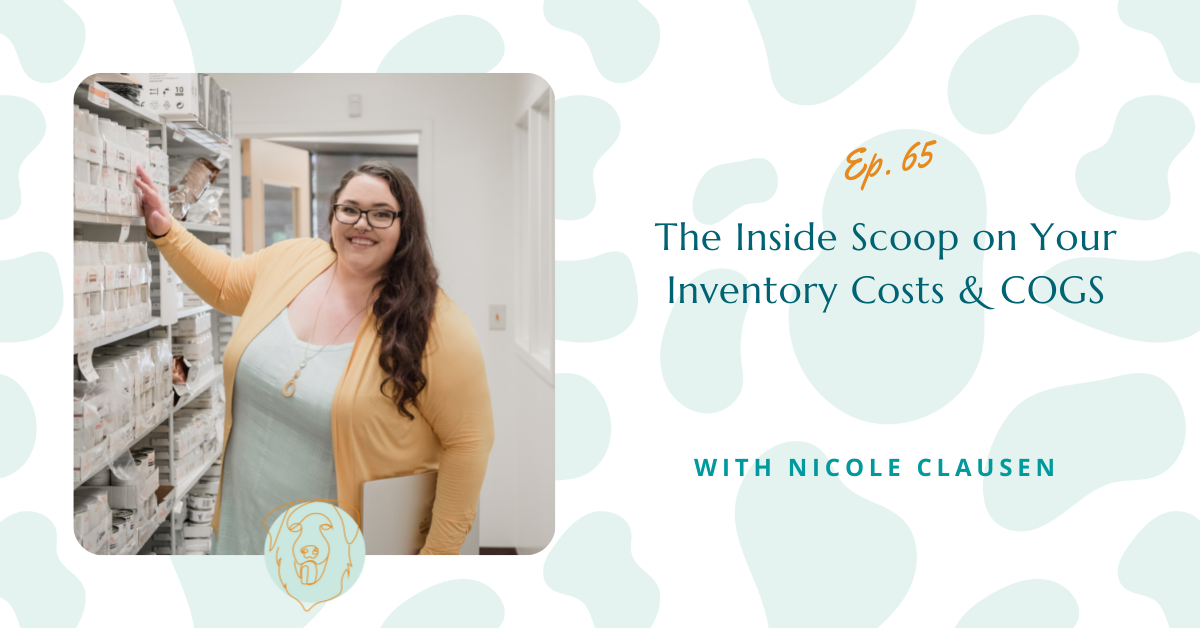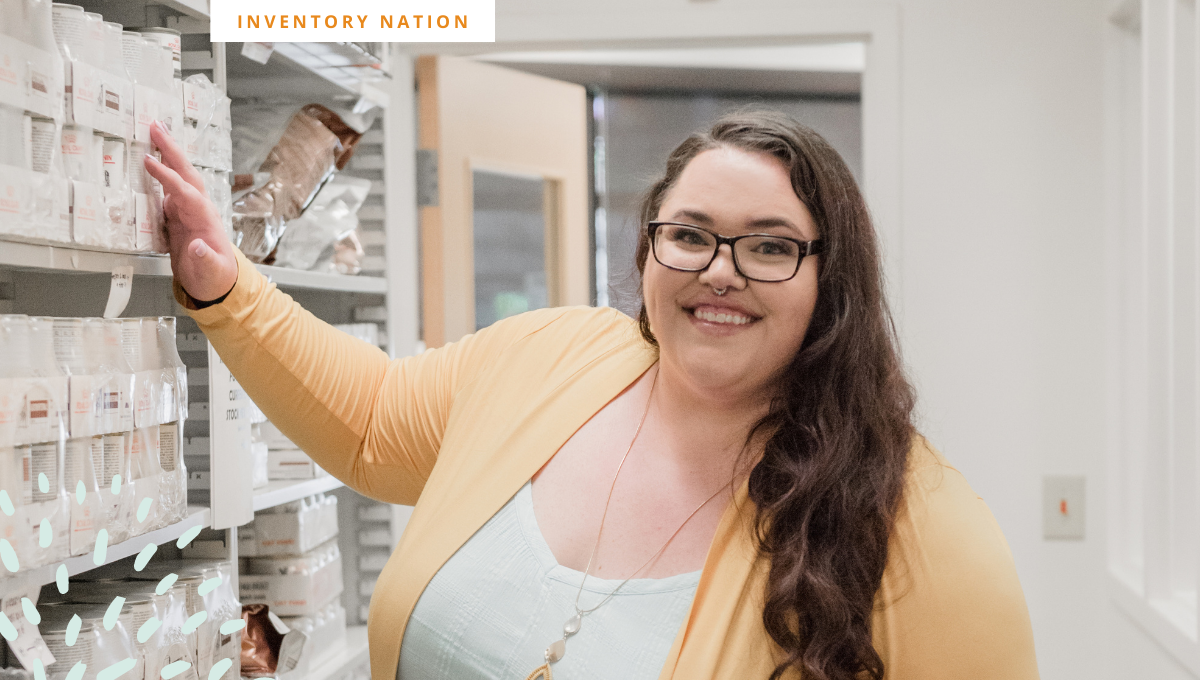TUNE IN: APPLE PODCASTS | SPOTIFY | GOOGLE PODCASTS | AMAZON MUSIC
Is your inventory manager empowered to protect your bottom line? If not, then you’re leaving money on the table that could be used instead to grow the healthiest, most robust veterinary practice possible! This episode of the Inventory Nation Podcast focuses on all things COGS, which stands for Cost of Goods Sold.

EPISODE HIGHLIGHTS
Is your inventory manager empowered to protect your bottom line? If not, then you’re leaving money on the table that could be used instead to grow the healthiest, most robust veterinary practice possible! This episode of the Inventory Nation Podcast focuses on all things COGS, which stands for Cost of Goods Sold. Host Nicole Clausen, president and inventory expert at Veterinary Care Logistics, walks us through both definitions and available systems to identify exactly where your practice’s costs lie, which when it comes to COGS means anything related to caring for a patient. You’ll learn about a great (free!) resource for tracking exactly where these expenditures are and what percentage they represent of your revenue year over year. Having a methodology in place provides not only a vital measure of your practice’s financial health but also a means for reducing costs through lean, intentional, highly effective inventory practices. Wouldn’t you rather spend resources on compensating your dedicated team than wasting dollars on expired products, diversion, mischarges, and other inventory-related vulnerabilities? Listen to this episode, and you’ll know exactly why the answer is a resounding: Yes!
Would you like to learn more about Inventory 911 Toolkit, our step-by-step blueprint to help inventory managers optimize knowledge, strategy, and confidence? Click here!
You can also join our virtual neighborhood for inventory managers and other veterinary professionals for free by visiting this link.
WHAT YOU’LL LEARN
- Why it’s so important to understand Cost of Goods Sold:
- Inventory management.
- Practice growth and profitability.
- Strategic thinking about transitions and the future of your practice.
- Defining Cost of Goods Sold:
- The direct costs of producing the goods sold by companies.
- Sometimes abbreviated as COGS.Â
- Labor and materials account for a large percentage of COGS.
- COGS also include direct expenses such as distribution and salesforce costs.
- How veterinary COGS differ from traditional manufacturing sectors:
- Anything related to caring for patients constitutes veterinary COGS.Â
- These costs are sometimes called “direct costs†or “cost of services†or “costs of goods and services.â€
- COGS can include: prescription diets, pharmaceuticals, white goods, consumables, in-house labs, imaging and care-related expenses.
- COGS do not include: Office or janitorial supplies (considered facility costs).
- The American Animal Association offers a free Chart of Accounts tool that enables accurate benchmarking. It includes line-item breakouts for each of a detailed subset of direct costs for various professional services and other expenses.
- COGS should be factored as a percentage of revenue, rather than a flat dollar amount that is hard to measure accurately year over year.
- The formula for figuring your COGS percentage is simple, but based on variables:
- Revenue.
- Cost of Goods Sold in dollars.
- Both sides must be factored into the equation.
- Managing COGS isn’t simply about spending less. It’s also about creating a lean and efficient inventory system and thoughtful pricing.
- Resist the urge to simply spend less! Instead, up your inventory management game!
- The standard percentage of COGS over revenue is 20%, but that number is targeted for small animal general practices. Large- or mixed-animal, specialty or emergency practices will have different goal COGS.
- Each veterinary practice’s product and service mix is very determinative of costs and its own unique applicable COGS percentage. Â
- Nicole highlights examples of inventory cost reduction and the resulting reallocation of resources to support growth, operational, personnel or other expenses. It really adds up!
- If resilient inventory systems aren’t in place or inventory managers aren’t empowered to get the training they need to execute, it can lead to many undesirable scenarios:
- Expired products.
- Products not moving.
- Theft or diversion.
- Mischarges.
- Don’t leave money on the table! When we decrease inventory costs we are setting up an immediate positive impact on growing and developing the most robust possible practice.
KEY QUOTES
- “Knowing and understanding your cost of goods sold is going to make a huge impact on your valuation.â€Â
- “If it’s purchased with the idea and intent to care for our patients, it probably is included in this term, Cost of Goods Sold.â€Â
- “When we are trying to decrease our inventory costs, it’s not simply just about spending less. We really want to optimize our inventory costs and our revenue to make sure we are looking at both sides of the coin.â€
- “We don’t simply want to spend less. We want to truly optimize our inventory by creating a lean and efficient inventory system and making sure that our pricing is where it needs to be as well.â€Â
- “When we reduce our inventory costs – especially if they are excessive because we don’t have inventory systems in place – (it) can have such a huge impact on a practice.â€Â
- “I like to think of (COGS) as a lever to practice growth and when it’s not properly maintained it can really hinder the profitability of a practice.â€
- “Practices – now more than ever – need to be creative about hiring and retaining team members and paying a living fair wage for all the incredible-ness and heart and soul they give every single day that is so valuable and deserves to be compensated.â€Â
LINKS + RESOURCES MENTIONED IN THE EPISODE
- American Animal Hospital Association: Chart of Accounts
- Veterinary Care Logistics: @Instagram
- Veterinary Care Logistics: Certified Veterinary Inventory Professional Program
ABOUT VCL
Veterinary Care Logistics serves veterinarians and their teams who are frustrated that their current inventory system is not functioning correctly and are facing out-of-control inventory costs and improperly stocked hospitals. VCL helps veterinarians through inventory analysis, comprehensive step-by-step action plans, and thorough team member training. My clients experience great success and rave about my work because I roll up my sleeves and get dirty working with your hospital to improve your inventory as if it was my own hospital.
